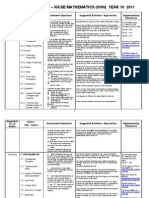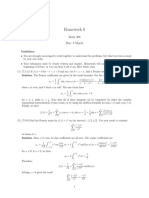0 ratings0% found this document useful (0 votes)
10 Maths Term 4 Unit Plan
10 Maths Term 4 Unit Plan
Uploaded by
Jeremy Jaques10 Maths Term 4 Unit Plan10 Maths Term 4 Unit Plan10 Maths Term 4 Unit Plan10 Maths Term 4 Unit Plan10 Maths Term 4 Unit Plan10 Maths Term 4 Unit Plan
Copyright:
© All Rights Reserved
Available Formats
Download as DOCX, PDF, TXT or read online from Scribd
Download as docx, pdf, or txt
10 Maths Term 4 Unit Plan
10 Maths Term 4 Unit Plan
Uploaded by
Jeremy Jaques0 ratings0% found this document useful (0 votes)
10 Maths Term 4 Unit Plan10 Maths Term 4 Unit Plan10 Maths Term 4 Unit Plan10 Maths Term 4 Unit Plan10 Maths Term 4 Unit Plan10 Maths Term 4 Unit Plan
Copyright
© © All Rights Reserved
Available Formats
DOCX, PDF, TXT or read online from Scribd
Share this document
Did you find this document useful?
Is this content inappropriate?
10 Maths Term 4 Unit Plan10 Maths Term 4 Unit Plan10 Maths Term 4 Unit Plan10 Maths Term 4 Unit Plan10 Maths Term 4 Unit Plan10 Maths Term 4 Unit Plan
Copyright:
© All Rights Reserved
Available Formats
Download as DOCX, PDF, TXT or read online from Scribd
Download as docx, pdf, or txt
0 ratings0% found this document useful (0 votes)
10 Maths Term 4 Unit Plan
10 Maths Term 4 Unit Plan
Uploaded by
Jeremy Jaques10 Maths Term 4 Unit Plan10 Maths Term 4 Unit Plan10 Maths Term 4 Unit Plan10 Maths Term 4 Unit Plan10 Maths Term 4 Unit Plan10 Maths Term 4 Unit Plan
Copyright:
© All Rights Reserved
Available Formats
Download as DOCX, PDF, TXT or read online from Scribd
Download as docx, pdf, or txt
You are on page 1/ 3
Unit Summary – 10 Maths – Term 4
Achievement By the end of unit, students should:
Standards Solve surface area and volume problems relating to composite solids.
Apply deductive reasoning to proofs and numerical exercises involving plane shapes.
Use triangle and angle properties to prove congruence and similarity.
Use trigonometry to calculate unknown angles in right-angled triangles.
Content Measurement and Geometry
Descriptions
- Solve problems involving surface area and volume for a range of prisms, cylinders and
composite solids (ACMMG242)
- Formulate proofs involving congruent triangles and angle properties (ACMMG243 )
- Apply logical reasoning, including the use of congruence and similarity, to proofs and
numerical exercises involving plane shapes (ACMMG244)
- Solve right- angled triangle problems including those involving direction and angles of
elevation and depression (ACMMG245)
Key Concepts Surface Area and Volume
/ Content
investigating and determining the volumes and surface areas of composite solids by
Elaborations
considering the individual solids from which they are constructed
Logical Proofs
applying an understanding of relationships to deduce properties of geometric figures (for
example the base angles of an isosceles triangle are equal)
distinguishing between a practical demonstration and a proof (for example demonstrating
triangles are congruent by placing them on top of each other, as compared to using
congruence tests to establish that triangles are congruent)
performing a sequence of steps to determine an unknown angle giving a justification in
moving from one step to the next.
communicating a proof using a sequence of logically connected statements
Pythagoras and Trigonometry
applying Pythagoras' Theorem and trigonometry to problems in surveying and design
Key Skills / Conceptual Understanding
Standard
distinguishing between a practical demonstration and a proof.
Elaborations
using authentic situations to apply knowledge and understanding of surface area and volume
Procedural Fluency
stating definitions for plane shapes
using formulas to find the surface areas and volumes of pyramids, right cones, spheres and
related composite solids
finding solutions to right-angle triangle problems using the sine, cosine and tangent ratios
Mathematical Modelling
-
Problem Solving
determining the evidence needed to support a conclusion or hypothesis
investigating and determining the volumes and surface areas of composite solids by
considering the individual solids from which they are constructed
applying Pythagoras's theorem and trigonometry to problems in surveying and design
using geometry software to investigate geometrical figures
Reasoning and Justification
formulating geometric proofs involving congruence and similarity
deducing properties of geometric figures
using deductive reasoning in presenting arguments and formal proofs
performing a sequence of steps to determine an unknown angle giving a justification in
moving from one step to the next
Key composite solid, surface area, volume, net, capacity
Terms/Vocab similarity, transformation, congruence, parallel, perpendicular
elevation, depression
communicating a proof using a sequence of logically connected statements
Lesson Sequence – 10 Maths – Term 4
Wk Lesson 1 Lesson 2 Lesson 3
1 Perimeter and Circumference Perimeter of Compound Shapes Area of Simple Shapes
- Calculate the perimeter of a - Calculate the perimeter of a - Convert units of area.
polygon. sector. - Find the area of rectangles and
- Calculate the circumference of a - Convert units of length. triangles.
circle. - Find the perimeter of composite - Find the area of quadrilaterals.
Chapter 6A shapes. - Find the area of a circle.
Chapter 6A Chapter 6C
2 Area of Compound Shapes Surface Area – Prisms and Surface Area – Prisms and
- Find the area of a sector. Cylinders 1 Cylinders 2
- Find the area of a composite - Find the surface area of a - Find the surface area of a general
shape. rectangular prism. prism.
Chapter 6C - Find the surface area of a - Find the surface area of a
cylinder. composite solid.
Chapter 6D Chapter 6D
3 MAY DAY HOLIDAY Volume – Prisms and Cylinders SPORTING CARNIVAL ?
- Find the volume of a right prism.
- Find the volume of a cylinder.
- Find the volume of an oblique
prism.
Chapter 6F
4 Volume – Composite Solids Pythagoras’ Theorem Pythagoras’ Theorem
- Find the volume of a composite - Find the hypotenuse of a triangle - Solve problems using Pythagoras’
solid. using Pythagoras’ theorem. theorem.
- Convert units of volume. - Find the side length of a triangle Chapter 6B
- Find the volume of any irregular using Pythagoras’ theorem.
prism. Chapter 6B
Chapter 6F
5 Trigonometric Ratios Finding Angles Applications of Trigonometry
- Recall the trigonometric ratios. - Find angles in a triangle using - Identify angles of depression and
- Solve a trig ratio for an unknown trig. elevation.
in the numerator. - Solve problems involving trig to - Solving problems with
- Solve a trig ratio for an unknown find an angle. trigonometry.
in the denominator. Chapter 4B Chapter 4C
Chapter 4A
6 Angle Geometry Congruence Similar Figures
- Use angles at a point. - Proving congruence in triangles. - Finding and using scale factor.
- Use angles in parallel lines. - Using congruence in proofs. - Write a similarity statement.
- Use exterior angles and angle Chapter 2B - Solve problems with similarity.
sums. Chapter 2D
- Calculate the angles in a regular
polygon.
- Use reasoning to solve for angles
in complex diagrams.
Chapter 2A
7 Proving similar triangles Revision – Length and Area Revision – Surface Area and
- Using similarity tests to prove Volume
similar triangles.
- Establishing and using similarity.
Chapter 2E
8 Revision – Trigonometry and TBA
Geometric Proofs
9 EXAM TBA TBA
10 TBA TBA TBA
You might also like
- 5 Mathematics Measurement & Geometry Levels 7-10ANo ratings yet5 Mathematics Measurement & Geometry Levels 7-10A1 page
- 10 Advanced Mathematics Measurement Planning DocNo ratings yet10 Advanced Mathematics Measurement Planning Doc2 pages
- 10 Advanced Mathematics Measurement Planning Doc (1)No ratings yet10 Advanced Mathematics Measurement Planning Doc (1)2 pages
- Geometry & Measurement Unit 4: Perimeter and Area of Plane Figures Unit 4: Similarity of FiguresNo ratings yetGeometry & Measurement Unit 4: Perimeter and Area of Plane Figures Unit 4: Similarity of Figures2 pages
- High School Geometry Curriculum: Course Description: This Course Involves The Integration of Logical Reasoning andNo ratings yetHigh School Geometry Curriculum: Course Description: This Course Involves The Integration of Logical Reasoning and52 pages
- Fall 2019-Spring 2020 Analytical GeometryNo ratings yetFall 2019-Spring 2020 Analytical Geometry13 pages
- Session 5 Math MATATAG CG For Unpacking For PrintingNo ratings yetSession 5 Math MATATAG CG For Unpacking For Printing6 pages
- _Course_Outline_for_MYP_5_Term_1__2023__2_No ratings yet_Course_Outline_for_MYP_5_Term_1__2023__2_3 pages
- MathsTraks: Geometry: A Collection of Blackline Masters for ages 11-14From EverandMathsTraks: Geometry: A Collection of Blackline Masters for ages 11-14No ratings yet
- Gert Sibande Maths Paper 2 Content Workshop (2 - 3 August 2024)No ratings yetGert Sibande Maths Paper 2 Content Workshop (2 - 3 August 2024)202 pages
- FKB 6thgrademath Utahmiddleschoolmathproject ch5 Parent Edition WorkbookNo ratings yetFKB 6thgrademath Utahmiddleschoolmathproject ch5 Parent Edition Workbook110 pages
- Math Final Geometry Standards 4 - 2 - 2018No ratings yetMath Final Geometry Standards 4 - 2 - 20189 pages
- WWW Nexuslearning Net Books Ml-Geometry Chapter4 ML Geometry Chapter 4 Review-TestNo ratings yetWWW Nexuslearning Net Books Ml-Geometry Chapter4 ML Geometry Chapter 4 Review-Test4 pages
- 2001 Elementary Differential Geometry Pressley100% (1)2001 Elementary Differential Geometry Pressley336 pages
- MYP Grade 9 Mathematics - International Baccalaureate - FutureSchoolNo ratings yetMYP Grade 9 Mathematics - International Baccalaureate - FutureSchool6 pages
- Investigation - Is There A Polygon Sum Formula?: You Will Need: ProtractorNo ratings yetInvestigation - Is There A Polygon Sum Formula?: You Will Need: Protractor20 pages
- Unit 5 - Multiply & Divide Fractions: Concept SkillsNo ratings yetUnit 5 - Multiply & Divide Fractions: Concept Skills2 pages
- Ch. 1 Symmetry and Surface Area - Review Notes: Objectives: - To Find Lines of Symmetry in 2-D Shapes and ImagesNo ratings yetCh. 1 Symmetry and Surface Area - Review Notes: Objectives: - To Find Lines of Symmetry in 2-D Shapes and Images11 pages
- Year 8 EOY Revision Topics - Includes All Previous ListsNo ratings yetYear 8 EOY Revision Topics - Includes All Previous Lists4 pages
- Grade: 5 Unit: 5 Measuring Polygons (2D Geometry & Measurement)No ratings yetGrade: 5 Unit: 5 Measuring Polygons (2D Geometry & Measurement)2 pages
- Grade 9 Lab Activities and Projects 2024-25No ratings yetGrade 9 Lab Activities and Projects 2024-2519 pages
- Mathematics Program Summary - HSC 2-Unit CourseNo ratings yetMathematics Program Summary - HSC 2-Unit Course1 page
- gr6m_geometry-chapter-plan_2017-05-25_44126No ratings yetgr6m_geometry-chapter-plan_2017-05-25_441263 pages
- Explorations and Discoveries in Mathematics, Volume 1, Using The Geometer's Sketchpad Version 4From EverandExplorations and Discoveries in Mathematics, Volume 1, Using The Geometer's Sketchpad Version 4No ratings yet
- Sum and Difference Identities For Sine and Tangent 1No ratings yetSum and Difference Identities For Sine and Tangent 126 pages
- Test On - Binomial, Geometry, Num. Th.,Seq & SerNo ratings yetTest On - Binomial, Geometry, Num. Th.,Seq & Ser1 page
- CHAPTER 16 Newton and Leibniz - GROUP 8No ratings yetCHAPTER 16 Newton and Leibniz - GROUP 864 pages
- The Mathematical Association The Mathematical GazetteNo ratings yetThe Mathematical Association The Mathematical Gazette4 pages
- RPH Form 4I 2019 Angles of Elevation and DepressionNo ratings yetRPH Form 4I 2019 Angles of Elevation and Depression3 pages
- Types of Triangles: Isosceles, Equilateral, Scalene, Obtuse. .100% (2)Types of Triangles: Isosceles, Equilateral, Scalene, Obtuse. .7 pages
- Robust Replication of Volatility DerivativesNo ratings yetRobust Replication of Volatility Derivatives35 pages
- Call 2024 1 International Medical School (Classe LM 41)No ratings yetCall 2024 1 International Medical School (Classe LM 41)21 pages
- Direction Cosines and Direction Ratios - YT - DoneNo ratings yetDirection Cosines and Direction Ratios - YT - Done17 pages
- Ma5355 Transform Techniques and Partial Differential Equations EnglishNo ratings yetMa5355 Transform Techniques and Partial Differential Equations English4 pages

























































































